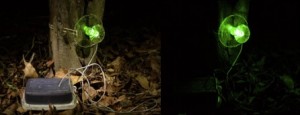WEDNESDAY, 15 APRIL 2015
Aristotle pondered this very question over 2,000 years ago. In the first century Pliny the Elder even had a little nibble on them. However it is a subject that had remained relatively unresolved. That is until researchers in a recent Cell Press journal, Current Biology, were able to ‘foray’ further and cast a new ‘light’ on this ‘enlightening’ topic. Last month, scientists at the University of São Paulo and Dartmouth College provided evidence to indicate that bioluminescence in fungi might serve to attract insects - including wasps, beetles, flies and ants - as a means to disperse their spores. As one of the researchers, Dr Cassius Stevani, remarked: "It appears that fungi make light so they are noticed by insects who can help the fungus colonise new habitats.”Bioluminescence is the biological production of light through chemical reaction and is generated by a diverse range of mechanisms. It has evolved independently in a variety of terrestrial and aquatic organisms where it can be used for attracting mates, communicating, luring prey, defence or as a metabolic byproduct. Some of the coolest natural phenomena are a result of bioluminescence. Glow in the dark waves are caused by agitated phytoplankton. The female anglerfish symbioses with bacteria, to create a bioluminescent dorsal spine, which it uses to lure unsuspecting prey. The lead singer from Owl City was particularly fond of fireflies, noting how they taught him how to dance. The purpose of this bioluminescence is however thought to lure potential mates...
Despite the incredible diversity of fungi, only 71 of the ~100,000 fungal species described have so far been documented as being bioluminescent. All are mushroom producing species of white-rot Basidiomycetes, and feed on decaying organic matter. Previous studies have suggested that is was a continuously produced, and metabolically costly, byproduct.
Oliveira et al. (2015) have however challenged this theory by finding that bioluminescence in the Brazilian Neonothopanus gardneri - which possess one of the larger and more illuminating mushrooms - may serve a more useful purpose to the fungi. They found that the bioluminescence is controlled by a temperature-compensated circadian clock - a similar mechanism to how your sleep patterns are controlled. The temperature-compensated circadian clock allows the fungi to lower the metabolic cost by only illuminating at night.
Professor Jay Dunlap, one of the leading authors of the study, suggests that this temperature controlled regulation “implies an adaptive function for bioluminescence.” The fungi are brighter at night when insects can detect them more easily, and during the day they prevent energy wastage by turning the costly bioluminescence down.
To test the adaptive significance of the fungal bioluminescence, the authors went to Brazilian coconut forests, where the luminescent ‘Flor de Coco (N. gardneri) grows naturally, and placed resin covered acrylic psuedo-mushrooms illuminated with LEDs in a similar green wavelength to that produced by the fungus.
The illuminated psuedo-mushrooms caught more insects than the unilluminated control group. The authors conclude that circadian controlled bioluminescence in N. gardneri optimises energy use by attracting insects when they are most likely to detect the green glow. The increased visitation by insects will benefit the fungi by helping in spore dispersal, something that is difficult under the forest canopy where the wind flow is weak.
By not providing evidence that the insects do disperse spores the authors fail to conclusively demonstrate that fungal bioluminescence is beneficial. The insects could for instance feed on the fungi or lay their eggs on the fruitbodies. It does however provide the most compelling theory yet. This may be addressed in future work, as Dunlap plans to examine the mushroom-insect interaction in greater detail with the use of inferred cameras.
Basidiomycetes, a group that include bioluminescent fungi, are crucial cogs in many ecosystems. They are important in the carbon cycle where they break down organic material, and can also parasitise commercially important plant species. In my own PhD I am even finding Basidiomycetes colonising the stems of Antarctic plants. Thus trying to elucidate how they are dispersed remains an important question to be resolved.
DOI:10.1016/j.cub.2015.02.021
Written by George Foot- PhD student at the Department of Plant Sciences and British Antarctic Survey researching plant-fungal symbioses in polar regions.

